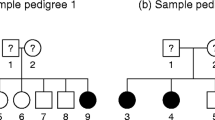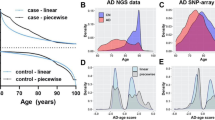Abstract
For genome-wide association studies in family-based designs, a new, universally applicable approach is proposed. Using a modified Liptak’s method, we combine the p-value of the family-based association test (FBAT) statistic with the p-value for the Van Steen-statistic. The Van Steen-statistic is independent of the FBAT-statistic and utilizes information that is ignored by traditional FBAT-approaches. The new test statistic takes advantages of all available information about the genetic association, while, by virtue of its design, it achieves complete robustness against confounding due to population stratification. The approach is suitable for the analysis of almost any trait type for which FBATs are available, e.g. binary, continuous, time-to-onset, multivariate, etc. The efficiency and the validity of the new approach depend on the specification of a nuisance/tuning parameter and the weight parameters in the modified Liptak’s method. For different trait types and ascertainment conditions, we discuss general guidelines for the optimal specification of the tuning parameter and the weight parameters. Our simulation experiments and an application to an Alzheimer study show the validity and the efficiency of the new method, which achieves power levels that are comparable to those of population-based approaches.
Similar content being viewed by others
References
Bertram L, Lange C, Mullin K, Parkinson M, Hsiao M, Hogan MF, Schjeide BMM, Hooli B, DiVito J, Ionita I, Jiang H, Laird NM, Moscarillo T, Ohlsen KL, Elliott K, Wang X, Hu-Lince D, Ryder M, Murphy A, Wagner SL, Blacker D, Becker KD, Tanzi RE (2008) Genome-wide association analysis reveals putative Alzheimer’s disease susceptibility loci in addition to APOE. Am J Hum Genet 83:623–632
Buxbaum JD, Silverman JM, Smith CJ, Greenberg DA, Kilifarski M, Reichert J, Cook EH, Fang JY, Song CY, Vitale R (2002) Association between a gabrb3 polymorphism and autism. Mol Psychiatry 7:311–316
CAMP R (1999) The childhood asthma management program (CAMP): design, rationale, methods (1999): childhood asthmamanagement program research group. Control Clin Trials 20:91–120
Chen WM, Abecasis GR (2007) Family-based association tests for genome-wide association scans. Am J Hum Genet 81:913–926
Devlin B, Roeder K (1999) Genomic control for association studies. Biometrics 55:997–1004
Devlin B, Roeder K, Wasserman L (2001) Genomic control, a new approach to genetic-based association studies. Theor Popul Biol 60:155–166
Elston RC, Gray-McGuire C (2004) A review of the ‘statistical analysis for genetic epidemiology’ (S.A.G.E.) software package. Hum Genomics 1:456–459
Fisher RA (1950) Statistical methods for research workers, 11th edn. Oliver & Boyd, Edinburgh
Fulker DW, Cherny SS, Sham PC, Hewitt JK (1999) Combined linkage and association sib-pair analysis for quantitative traits. Am J Hum Genet 64:259–267
Gatz M, Reynolds CA, Fratiglioni L, Johansson B, Mortimer JA, Bergs S, Fiske A, Pedersen NL (2006) Role of genes and environments for explaining Alzheimer’s disease. Arch Gen Psychiatry 63:168–174
Grupe A, Abraham R, Li Y, Rowland C, Hollingworth P, Morgan A, Jehu L, Segurado R, Stone D, Schadt E, Karnoub M, Nowotny P, Tacey K, Catanese J, Sninsky J, Brayne C, Rubinsztein D, Gill M, Lawlor B, Lovestone S, Holmans P, O’Donovan M, Morris JC, Thal L, Goate A, Owen MJ, Williams J (2007) Evidence for novel susceptibility genes for late-onset Alzheimer’s disease from a genome-wide association study of putative functional variants. Hum Mol Genet 16:865–873
Hensen P, Windemuth C, Huffmeier U, Ruschendorf F, Stadelmann A, Hoppe V, Fenneker D, Stander M, Schmitt-Egenolf M, Wienker TF, Traupe H, Reis A (2003) Association scan of the novel psoriasis susceptibility region on chromosome 19: evidence for both susceptible and protective loci. Exp Dermatol 12:490–496
Ionita-Laza I, McQueen MB, Laird NM, Lange C (2007) Genome-wide weighted hypothesis testing in family-based association studies, with an application to a 100K scan. Am J Hum Genet 81:607–614
Laird NM, Lange C (2006) Family-based designs in the age of large-scale gene association studies. Nat Rev Genet 7:385–394
Laird NM, Horvath S, Xu X (2000) Implementing a unified approach to family-based tests of association. Genet Epidemiol 19 Suppl 1:S36–S42
Lange C, Laird NM (2002) On a general class of conditional tests for family-based association studies in genetics: the asymptotic distribution, the conditional power, and optimality considerations. Genet Epidemiol 23:165–180
Lange C, DeMeo DL, Laird NM (2002) Power and design considerations for a general class of family-based association tests: quantitative traits. Am J Hum Genet 71:1330–1341
Lange C, DeMeo DL, Silverman EK, Weiss ST, Laird NM (2003a) Using the noninformative families in family-based association tests: a powerful new testing strategy. Am J Hum Genet 73:801–811
Lange C, Lyon H, DeMeo D, Raby B, Silverman EK, Weiss ST (2003b) A new powerful non-parametric two-stage approach for testing multiple phenotypes in family-based association studies. Hum Hered 56:10–17
Lasky-Su J, Lyon HN, Emilsson V, Heid IM, Molony C, Raby BA, Lazarus R, Klanderman B, Soto-Quiros ME, Avila L, Silverman EK, Thorleifsson G, Thorsteinsdottir U, Kronenberg F, Vollmert C, Illig T, Fox CS, Levy D, Laird NM, Ding X, McQueen MB, Butler J, Ardlie K, Papoutsakis C, Dedoussis G, O’Donnell CJ, Wichmann HE, Celedon JC, Schadt E, Hirschhorn J, Weiss ST, Stefansson K, Lange C (2008) On the replication of genetic associations: timing can be everything. Am J Hum Genet 82:849–858
Levin AM, Machiela MJ, Zuhlke KA, Ray AM, Cooney KA, Douglas JA (2008) Chromosome 17q12 variants contribute to risk of early-onset prostate cancer. Cancer Res 68:6492–6495
Li H, Wetten S, Li L, St Jean PL, Upmanyu R, Surh L, Hosford D, Barnes MR, Briley JD, Borrie M, Coletta N, Delisle R, Dhalla D, Ehm MG, Feldman HH, Fornazzari L, Gauthier S, Goodgame N, Guzman D, Hammond S, Hollingworth P, Hsiung GY, Johnson J, Kelly DD, Keren R, Kertesz A, King KS, Lovestone S, Loy-English I, Matthews PM, Owen MJ, Plumpton M, Pryse-Phillips W, Prinjha RK, Richardson JC, Saunders A, Slater AJ, St George-Hyslop PH, Stinnett SW, Swartz JE, Taylor RL, Wherrett J, Williams J, Yarnall DP, Gibson RA, Irizarry MC, Middleton LT, Roses AD (2008) Candidate single-nucleotide polymorphisms from a genome-wide association study of Alzheimer’s disease. Arch Neurol 65:45–53
Liptak T (1958) On the combination of independent tests. Magyar Tud Akad Mat Kutatȯ Int Közl 3:171–197
Lyon H, Lange C, Lake S, Silverman EK, Randolph AG, Kwiatkowski D, Raby BA, Lazarus R, Weiland KM, Laird NM, Weiss ST (2004) IL10 gene polymorphisms are associated with asthma phenotypes in children. Genet Epidemiol 26:155–165
Price AL, Patterson NJ, Plenge RM, Weinblatt ME, Shadick NA, Reich D (2006) Principal components analysis corrects for stratification in genome-wide association studies. Nat Genet 38:904–909
Pritchard JK, Stephens M, Donnelly P (2000) Inference of population structure using multilocus genotype data. Genetics 155:945–959
Qu H, Tessier M-C, Hudson TJ, Polychronakos C (2005) Confirmation of the association of the r620w polymorphism in the protein tyrosine phosphatase ptpn22 with type 1 diabetes in a family-based study. J Med Genet 42:266–270
Rabinowitz D, Laird N (2000) A unified approach to adjusting association tests for population admixture with arbitrary pedigree structure and arbitrary missing marker information. Hum Hered 50:211–223
Reiman EM, Webster JA, Myers AJ, Hardy J, Dunckley T, Zismann VL, Joshipura KD, Pearson JV, Hu-Lince D, Huentelman MJ, Craig DW, Coon KD, Liang WS, Herbert RH, Beach T, Rohrer KC, Zhao AS, Leung D, Bryden L, Marlowe L, Kaleem M, Mastroeni D, Grover A, Heward CB, Ravid R, Rogers J, Hutton ML, Melquist S, Petersen RC, Alexander GE, Caselli RJ, Kukull W, Papassotiropoulos A, Stephan DA (2007) Gab2 alleles modify Alzheimer’s risk in APOE epsilon4 carriers. Neuron 54:713–720
Silverman EK, Kwiatkowski DJ, Sylvia JS, Lazarus R, Drazen JM, Lange C, Laird NM, Weiss ST (2003) Family-based association analysis of beta2-adrenergic receptor polymorphisms in the childhood asthma management program. J Allergy Clin Immunol 112:870–876
Smoller JW, Rosenbaum JF, Biederman J, Kennedy J, Dai D, Racette SR, Laird NM, Kagan J, Snidman N, Hirshfeld-Becker D, Tsuang MT, Sklar PB, Slaugenhaupt SA (2003) Association of a genetic marker at the corticotropin-releasing hormone locus with behavioral inhibition. Biol Psychiatry 54:1376–1381
Smoller JW, Yamaki LH, Fagerness JA, Biederman J, Racette S, Laird NM, Kagan J, Snidman N, Faraone SV, Hirshfeld-Becker D, Tsuang MT, Slaugenhaupt SA, Rosenbaum JF, Sklar PB (2005) The corticotropin-releasing hormone gene and behavioral inhibition in children at risk for panic disorder. Biol Psychiatry 57:1485–1492
Spielman RS, Ewens WJ (1998) A sibship test for linkage in the presence of association: The sib transmission/disequilibrium test. Am J Hum Genet 62:450–458
Van Steen K, McQueen MB, Herbert A, Raby B, Lyon H, Demeo DL, Murphy A, Su J, Datta S, Rosenow C, Christman M, Silverman EK, Laird NM, Weiss ST, Lange C (2005) Genomic screening and replication using the same data set in family-based association testing. Nat Genet 37:683–691
Won S, Morris N, Lu Q, Elston RC (2009) Choosing an optimal method to combine p-values. Stat Med 28:1537–1553
Won S, Wilk JB, Mathias RA, O’Donnell CJ, Silverman EK, Barnes K, O’Connor GT, Weiss ST, Lange C (2009) On the analysis of genome-wide association studies in family-based designs: a universal, robust analysis approach and an application to four genome-wide association studies. Plos Genet, in press
Author information
Authors and Affiliations
Corresponding author
Rights and permissions
About this article
Cite this article
Won, S., Bertram, L., Becker, D. et al. Maximizing the Power of Genome-Wide Association Studies: A Novel Class of Powerful Family-Based Association Tests. Stat Biosci 1, 125–143 (2009). https://doi.org/10.1007/s12561-009-9016-z
Received:
Accepted:
Published:
Issue Date:
DOI: https://doi.org/10.1007/s12561-009-9016-z




